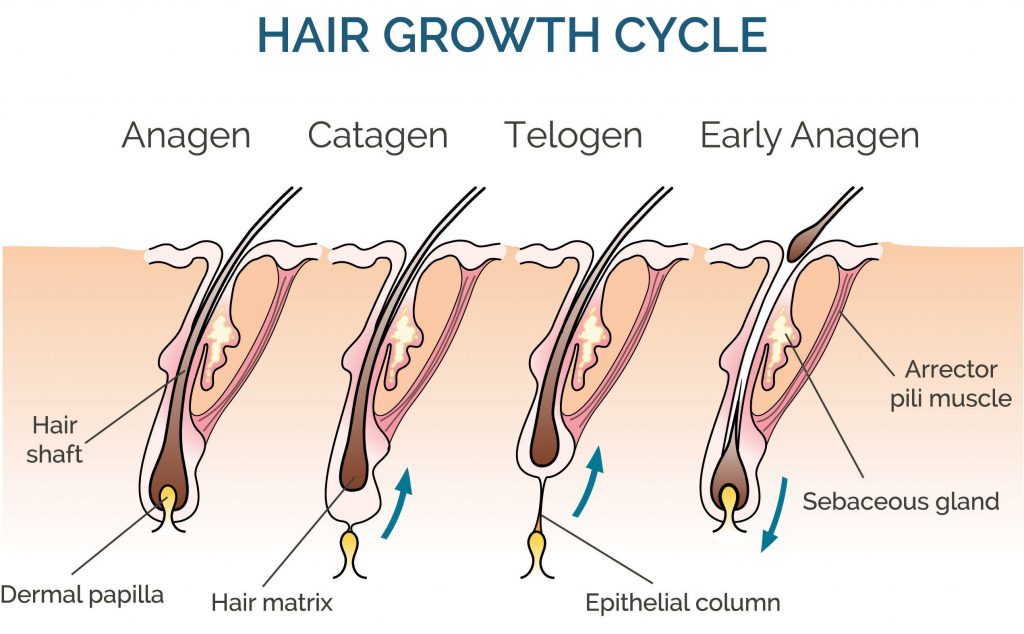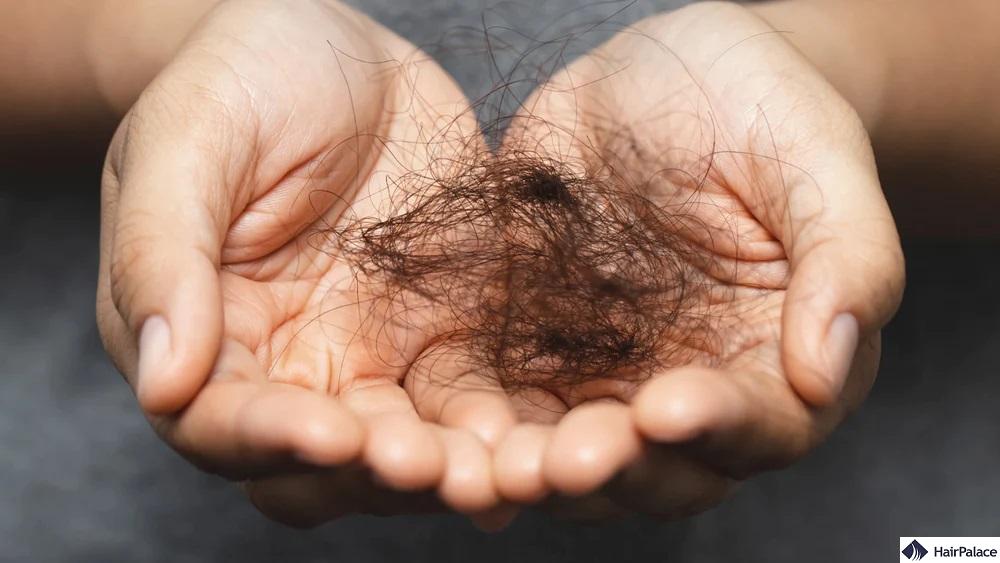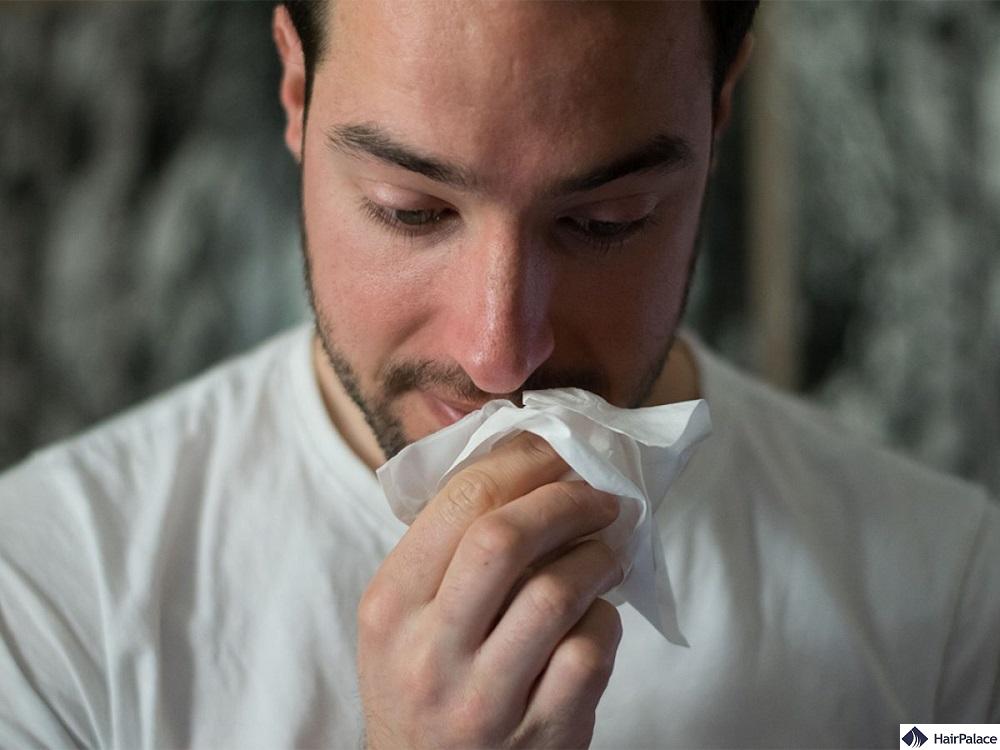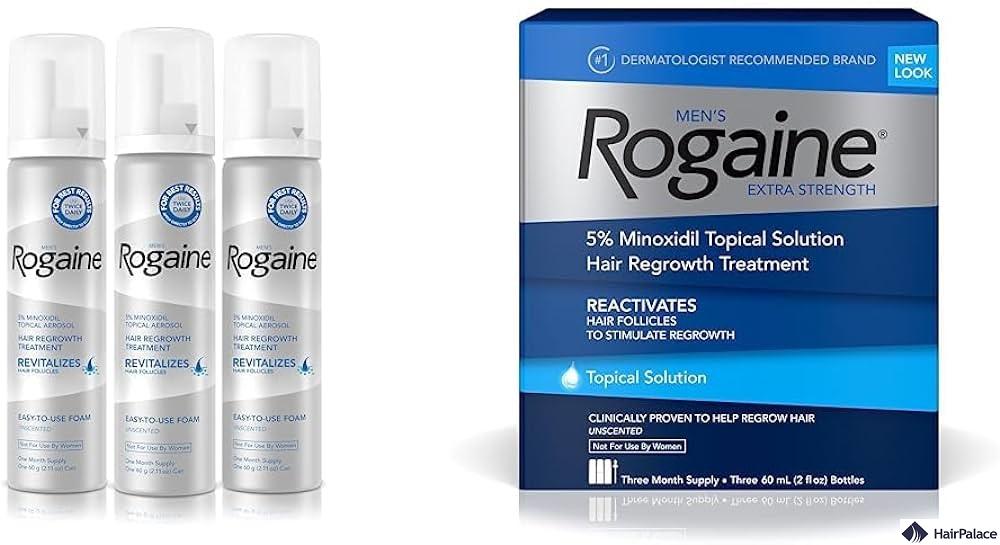Seasonal Hair Loss Explained: Causes & Treatment

Seasonal hair loss is a temporary condition where individuals experience increased hair shedding during specific times of the year, typically in the fall or spring.
This phenomenon is believed to be related to changes in daylight and hormonal fluctuations that affect the hair growth cycle.
While it can be alarming, seasonal hair loss is usually temporary, and hair growth typically returns to normal after the season passes.
This article will delve into the intricacies of change of season hair loss.
We will explore its potential causes, manifestations, and the proactive steps one can take.
Normal hair loss
It’s normal to lose 50-100 hairs per day due to the natural end of the telogen phase.
Sometimes this might seem like a lot, especially when brushing or washing hair, but it’s a part of the hair’s natural cycle.
Our hair goes through a life cycle that includes four phases:
- Anagen phase: The first stage lasts for about 2 to 7 years. This is the time when cells inside the hair bulb divide, leading to the creation of new hair shafts.
- Catagen phase: Also known as the transitional phase, this stage lasts for about 2 to 3 weeks. This is when hairs shrink and slow down growth which eventually comes to a complete halt. Hairs will detach from the follicle but will remain inside as club hair. Around 5% of your hairs are in this phase at any given time.
- Telogen phase: This is also referred to as the resting phase, lasting around 3 months. Hairs will remain dormant inside the hair follicles. Meanwhile, new hair strands begin to sprout underneath these dormant follicles.
- Exogen phase: This is known as the shedding phase. Old hair sheds, and the follicles will return to the growth phase. This is the phase that causes you to lose those 50-100 hairs each day, but these hairs are easily recreated by the natural hair growth cycle.

While daily shedding is normal, there are times when hair loss might be a sign of a more significant issue.
If you feel like you’re losing more hair than usual, or your hair comes out in patches, you may want to consult with a healthcare professional.
What is seasonal hair loss?
This condition is when individuals experience an increase in hair shedding during certain times of the year.
This happens most commonly in the fall and, to a lesser extent, in the spring.
It is believed that this has to do with the body’s natural response to changes in light exposure, along with other seasonal factors.
These changes might affect the hair growth cycle, leading to increased shedding.
Just as animals shed fur in synchronization with seasonal changes, humans, too, might have an evolutionary remnant that triggers shedding.
Though the increased hair loss can be alarming to some, it’s typically temporary and returns to normal as the season progresses.
Signs of seasonal hair shedding

This type of hair loss, while not fully understood, manifests in a few distinguishable ways.
One of the most noticeable is an increase in the number of hairs shed daily.
While it’s normal to lose around 50-100 hairs per day, someone experiencing hair loss in the winter season might find more hairs falling out than usual.
This increased hair fall may last for a couple of weeks, but this type of hair loss typically resolves on its own with healthy hair growth returning.
Seasonal shedding usually occurs around the same time each year, with most people experiencing it in the fall, or sometimes the spring season as well.
In certain cases, it’s hard to notice the signs of hair loss as it usually affects hairs all over the scalp and isn’t concentrated on a single area.
People experiencing this type of hair loss usually don’t have any other systemic symptoms.
If hair loss is accompanied by other health issues, it’s likely not just seasonal and should be evaluated by a medical professional.
Causes of seasonal hair loss
Research on the topic is still ongoing. However, several theories and factors are believed to contribute to the phenomenon.
The most widely accepted one has to do with the changes in daylight exposure.
As days become shorter or longer our sunlight exposure changes, which may affect hormone and melatonin production.
The other theory is that just like animals, humans may have an evolutionary trigger that causes increased shedding at certain times of the year.
Other contributing factors may have to do with the fluctuations in temperatures, hormonal shifts that happen or certain dietary changes.
Can allergies cause seasonal hair loss?

Allergies themselves aren’t a direct cause in the same sense that changes in daylight or hormonal shifts might be.
However, allergies can indirectly contribute to conditions or behaviours that may lead to increased hair fall.
While allergies might play a role in hair health for some individuals, they’re not commonly cited as a primary cause.
How to treat seasonal hair shedding
Seasonal hair loss autumn is typically a temporary phenomenon, and in many cases, the hair growth cycle returns to its normal pattern without any intervention.
However, for those who are concerned or want to address the increased shedding proactively, here are some potential treatment options and preventive measures:
1. Ensure that your hair and scalp are healthy
Avoid hairstyles that pull on the hair, such as tight ponytails or braids.
Minimize the use of heat styling tools and chemical treatments, and switch to a wide-tooth comb.
You should also get into the habit of applying regular scalp massages and using gentle hair care products.
This can decrease possible scalp irritation and help you maintain the amount of hair you have.
2. Reduce stress
Chronic stress can exacerbate hair shedding.
Find ways to manage and reduce stress, such as through meditation, exercise, or relaxation techniques.
Engage in activities that take your mind off everyday issues and pick up a hobby that brings joy.
3. Use medication

An over-the-counter topical treatment such as minoxidil may stimulate hair regrowth in those with thinning hair.
However, this medication has to be used continuously to maintain positive benefits.
Furthermore, minoxidil comes with a wide variety of possible side effects which you should be aware of before usage.
Can you prevent seasonal hair loss?
While it’s unclear if it can be entirely prevented, there are measures individuals can adopt to support overall hair health and potentially minimize the effects.
1. Maintain a balanced diet
Ensure you’re eating a balanced diet rich in protein, iron, and other essential nutrients.
Hair is primarily composed of protein, so a protein-rich diet can support hair health.
These foods are also important to supply yourself with enough vitamins and minerals to promote hair health.
Supplements like biotin, iron, zinc, vitamin D, and omega-3 fatty acids might help in promoting a healthy scalp and hair.
2. Use gentle hair care products
You should aim to use shampoos that are sulfate and additive-free.
It’s also best to reduce the usage of heat-styling tools and harsh chemical treatments such as perms or bleaching.
It’s also a good idea to apply deep conditioning treatments to maintain healthy hair and reinforce it against environmental factors.
3. Stay hydrated
Just like a balanced diet, drinking enough water can help your body function the way it’s supposed to and ensure that your follicles stay nourished.
Seasonal Hair Loss FAQ
The condition is typically temporary, and the hair usually grows back as the season progresses or changes.
It typically lasts for a few weeks to a couple of months. However, the exact duration can vary among individuals. Most people notice a return to their usual shedding pattern as the season progresses or changes.
While it’s challenging to completely prevent it, supporting hair health through a balanced diet, gentle hair care, stress management, and proper hydration can help mitigate its effects.
Some people experience increased hair shedding during certain times of the year, commonly referred to as seasonal hair loss spring or autumn.
Seasonal allergies can only contribute to hair loss if they lead to scalp irritation, itching, or inflammation from consistent scratching. However, they are not a primary cause of hair loss.
This is a completely normal phenomenon for many people, with increased hair shedding typically occurring during specific times of the year, often in the fall.
Last medically reviewed on July 11th, 2024
- Phillips TG, Slomiany WP, Robert Allison II. Hair loss: common causes and treatment. American family physician. 2017 Sep 15;96(6):371-8.https://www.aafp.org/pubs/afp/issues/2017/0915/p371.html
- International Society of Hair Restoration Surgery: 2022 Practice Census Resultshttps://ishrs.org/wp-content/uploads/2022/04/Report-2022-ISHRS-Practice-Census_04-19-22-FINAL.pdf


